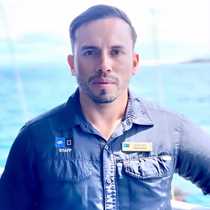Española Island
The oldest of the Galápagos Islands was at its best today. Galápagos is a semi-tropical archipelago that has been isolated from the continent for millions of years allowing the evolution of unique species with the help of the geographical isolation and the isolation of behavior. On National Geographic Islander we navigated to the south of the enchanted islands, arriving to the oldest island in this archipelago. After a wet landing on a beautiful white sand beach known as Gardner, we decided to explore the wonders of the marine world. Many Galápagos sea lions were lying down while some others came to play with beginner snorkelers by the shoreline. Nursing pups were seen all along the beach in many of the harems, which were guarded by their own alpha male.
Another interesting species was the Hood mockingbird, being one of the four endemic species of mockingbirds in the Galápagos. It is the largest of all Galápagos mockingbirds, and it is only found on Española Island — nowhere else in the world.
After midday we repositioned our vessel to another great visitor site on this island. This time we landed on Suarez Point, a place with amazing landscapes, life everywhere you walked. The high level of endemism on Española could have be seen everywhere on this very special spot on Earth; there are many endemic species: Hood mockingbird, Hood lava lizard, Waved albatross and Hood marine iguanas among other magical masterpieces of nature that coexist here.
The highlight of the afternoon’s expedition was the Waved albatross. These birds are very big and have the largest wingspan of any bird in Galápagos. Waved albatross spend up to seven years out of the reach of land, until they become sexually mature to finally settle feet on the ground for the first time. These birds that were described in The Rime of the Ancient Mariner gave us a spectacular show while performing the mating dance of their courtship ritual.
The cliffs were not completely lonely; they were guarded by the top land predator within the enchanted islands, a raptor known as the Galápagos hawk. One of the last arrivals as a species, this bird is the king of the area; it feeds on anything it desires. Hawks in the islands have a much reduced population, so seeing a couple this afternoons was very exciting.
After a spectacular day of exploring the magic of endemic species, we moved on with our expedition this week in these islands famous for inspiring Darwin.




